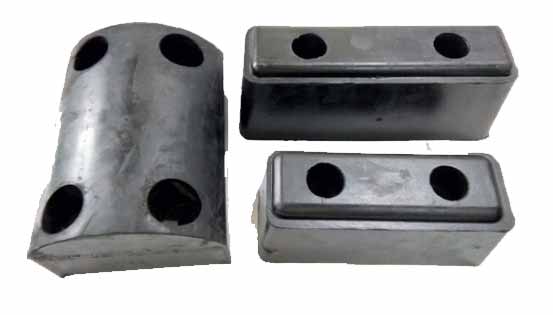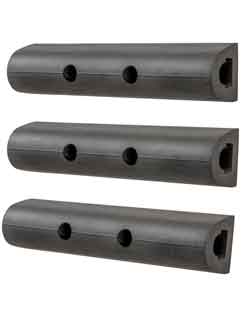Rubber bumpers are widely used in various applications. They are defined as devices used to absorb shock between two objects. The most common application of bumpers is in vehicles. A bumper is made of various materials that can move easily. They can also have pneumatic or hydraulic cylinders which allow them to move when hit. The bumper is used to minimize the effect of collisions. Materials used can be heavy steel, plastic, painted light metal and rubber. These bumpers are widely used because they are susceptible to damage from small contacts. They are considered to be elastomeric hardware devices which are used for edge protection, cushioning, and impact absorption.
Types of rubber used in rubber bumper
Common bumper materials are:
- Natural Rubber
- Synthetic Rubber like Silicone, Polysulfide, urethane, polyurethane, and Butyl
Certain specifications are to be considered for selecting bumpers. They are as follow:
- Shapes: Cylindrical, hemispherical, hexagonal, oval, rectangular, square and roll stock.
- Dimensions: With the type of bumper, the dimensions vary. Head height, head diameter, stem length, stem width, overall thickness are some aspects that describe the dimensional features of bumpers.
- Material of Construction: The material used to make a bumper should have elastic properties as well as the required hardness.
- Hardness: Hardness allows the bumper to be rigid and resistant to pressure.
- Compatibility Chart: It is to be noted since bumpers should be compatible with chemicals they come into contact with, an industrial elastomeric or rubber product manufacturer needs to consult a compatibility chart.


Types of Bumpers
- Recess Bumpers: These are used because they offer a cushioning effect as well as a non-skid surface to the product. These bumpers are also provided with rubber feet which is mechanically fixed using a rivet or screw.
- Stem Bumpers: These type of bumpers are inserted into a pre-drilled hole. They are used as bases for cabinets and small boxes, to prevent scratches and keep them from slipping.
- Plug Bumpers: These are used either as a nipple. Can also be used as a hole plug.
- Screw and Tack Bumpers: In screw bumpers, screws are there for attaching the bumpers to the surface.Tack bumpers eliminate sound and are used to protect any surface from damage.
- Grommet Bumpers: They are inserted into a pre-drilled hole with ease and can be used as a rubber feet.
- They provide protection to surfaces and allow spacing and ventilation.
- The vibration in an equipment is controlled by using bumper.
- The rubber bumper also offers sliding resistance.
- These bumpers absorb and deliver momentum during collisions, which reduces the effect of collision.
- They protect the surfaces from scratches and skidding.
- The main advantage of rubber and plastic bumpers is that they can be manufactured in the desired colors.
- Used in the cooling system of vehicles.
- They are used to provide protection for safety related equipment like taillights, headlamps, and parking lights in low speed collisions.
- Bumpers offer reduced sound qualities for cabinets and vanity doors.
- They provide additional support for printed circuit boards.
- Heavy duty rubber dock bumpers are used for both vehicle and loading dock applications.
- Anti Vibration Mountings
- Automobile Rubber Products
- Calendered Rubber Products
- Extruded Rubber Products
- Medical Rubber Products
- Metal Bonded Components
- Rubber Adhesives & Sealants
- Rubber Ball
- Rubber Bands
- Rubber Beading
- Rubber Bearing
- Rubber Belt
- Rubber Buckets
- Rubber Bullets
- Rubber Cable
- Rubber Coating
- Rubber Duct
- Rubber Expansion Joints
- Rubber Flooring/Matting
- Rubber Footwear
- Rubber Gloves
- Rubber Injection Parts
- Rubber Lining
- Rubber Magnets
- Rubber Molded Products
- Rubber Pads
- Rubber Rollers
- Rubber Stopper
- Rubber Suit
- Rubber Track
- Rubber Valve
- Rubber Balloon
- Rubber Stamps
- Rubber Fenders
- Acrylic Rubber (ACM)
- Butadiene Rubber (BR)
- Butyl Rubber (IIR)
- Chlorosulfonated Polyethylene(CSM)/ Hypalon
- Ethylene Propylene Diene Monomer
- Fluoroelastomers (FKM)/Viton
- Isoprene Rubber (IR)
- Nitrile Rubber (NBR)
- Perfluoroelastomer (FFKM)
- Polychloroprene (CR)/Neoprene
- Polysulfide Rubber (PSR)
- Silicone Rubber (SiR)
- Styrene Butadiene Rubber
How to Make a Custom Rubber Stamp?
Whenever designing a custom stamp for your company, never compromise on its quality because in the end it is the most...
Read MoreLatex and Silicone Rubber Tubing - A Comparison!
Many industries use rubber tubing for various purposes. In fact, various types of rubber tubing are used for different applications...
Read MoreSilicone vs Acrylic Adhesive- A Comparison
Silicon and acrylic adhesives are those rubber adhesives that are widely used in Polyimide tapes. In fact, the polyimide...
Read More

